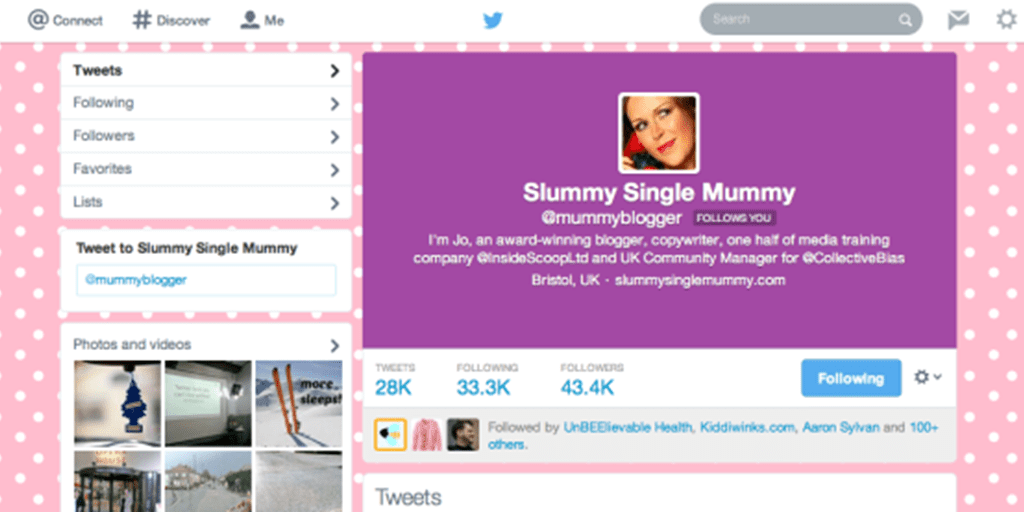Jo Middleton aka Slummy Single Mummy aka @mummyblogger started blogging in 2009. She originally wanted to showcase her writing talent, which according to her wasn’t that much at the time. She didn’t have a degree in journalism, nor did she have much experience in writing. She had done couple of breast feeding articles for a small publication targeted to mothers. But she was enthusiastic and wanted to learn more, so she started a blog.
First lesson: you don’t have to be a professional writer to start a blog. If there is something you’d like to write about, just start. Don’t worry if it’s not a global success right away – we promise it won’t be. Just write for fun and for yourself, and if it turns into something more, then great. To become a good blogger takes time and there is only one way to do it – you have to write a lot.
18 months ago Jo had 7k followers on her Twitter account. She decided to push it to 10k by the end of 2012 and one hour before midnight on New Year Eve she achieved it. How? She found followers by following people who followed someone similar to her. To boost her efforts she used ‘JustUnFollow‘ which lets you see who doesn’t follow you back. The way to do it is to follow a bunch of people, then wait they follow you back. If they don’t, you have to unfollow them. If you follow more people than you get followers you will get stuck at 2,000 and Twitter won’t let you follow more people.
When she reached 10k followers on Twitter she decided* the sky is the limit. And now she’s got over 43k followers. Why this is important? She gets 30% of her web traffic (and ultimately sales) from Twitter.
*) Like anything in life, all we need is a decision. The rest is work.
Lesson no 2: Anyone can build a huge following on Twitter. You don’t have to be Aston Kutcher (though it helps). It takes constant effort and time, but it’s not difficult.
Lesson no 3: If you are building a business, any business, it’s important to grow your following as it is your own media channel. Only it’s FREE. If you build a targeted and loyal audience and create high quality, interesting content for them, they will come look out for you and will become your advocates ultimately recommending you to people who might be interested in buying from you.
You have to be somewhat open on social media. It’s like any interaction with people. If you go to a party and stand in the corner sulking it’s unlikely you make lots of friends. But if you have something interesting to say, you expose your personality and you are professional, friendly and helpful the chances are you will make lots of contacts and friends on social media.
Lesson no 4: You gotta show your personality and expose something about yourself if you want people be interested in what you are saying. Don’t take yourself too seriously, relax. You are not the centre of the universe (on-line or off-line) and showing a little bit of who you are will not hurt.
If you want to become a blogger, it can be daunting to create a presence when there are so many big bloggers and corporations with huge resources they can throw at the quality of their content. As a single person blogging after work it’s simply impossible to compete with their technical quality, thus you should focus on the relationships you can build with your audience. To build a relationship, this goes back to the previous point, you have to show your audience who you are. Would you talk to a person who was wearing a mask?
Lesson no 5: To build an audience as an amateur blogger you should focus on building relationships with your audience.
Who is your audience? The exercise we did was to cut out a picture of the person you are talking to from a magazine. We gave her a name, an age, how many kids she has (or none), where she lives, what kind of husband she has and what is her favourite past time.
Lesson no 6: Knowing who you talk to is the most important thing before you can start building an audience. Have a picture of her next to your computer and talk to her. You want to help her solve her problems or get her excited and passionate about things.
Example: FINSK Shoes. Don’t sell her shoes, solve her problems. Joanna from Finsk gave her target girl a name: ‘Olivia’. She’s 30 years old and has two kids aged 2 and 7. Her worry is that her friends who don’t have kids are still having fun and appear far sexier and fashionable than her. FINSK shoes can solve that problem! This is the starting point for content creation.
Lesson no 7: What to tweet or blog?
– Help people, solve problems. Share resources and articles that are relevant to your target market.
– Show something behind the scenes. If you are making something, show people where you get the ingredients or tell an interesting story about people working with your product. Reveal the personalities, locations and details about the process how your product is being made.
– Make them excited and passionate about you and/or your product. Show your own excitement and passion.
– Use images, they get shared. Use pictures to lighten up your blog or stand alone in a tweet with a good caption.
– Links to good quality pages and content make it more likely people share your tweets.
Twitter
As you build your following you should create lists. If you follow 1,000 people it’s impossible to see what the people you really want to hear from are saying. You can create lists based on the type of content such as ‘Startup info’ or based on who’s tweeting ‘DrivenWoman members’.
HootSuite
To manage lists and to follow #hashtags (which are discussions on a particular topic such as #startups) you can use HootSuite where you can see many different streams in the same view. HootSuite is also great for scheduling content.
BufferApp
You don’t have time to be posting high quality Tweets all the time. However, as it’s your advertising media, it might make sense to have tweets spread out through out the day to remind people what you have to say. Buffer lets you create time slots in advance and then when you find or create content it will schedule that content for you so it gets spread out during the day.
Twitter vocabulary
Retweet (RT) = when someone ‘retweets’ ie shares your tweet on Twittter. You can retweet people by pressing the ‘retweet’ button below a tweet. If you retweet from a different program (such as HootSuite) letters RT may appear. RT is a shorthand for retweet. You don’t have to add it manually, unless you have a specific message such as ‘Please RT this article.‘ People are 18 times more likely to retweet you if you ask. However, don’t use their goodwill to sell your product. Ask them to spread your passion or mission or if you genuinely need help.
Direct message (DM) = You can send Direct messages on Twitter to people who follow you. Those messages no one else can see. You still have to stick to 140 letters.
@someone = When you put someone’s ‘twittter handle‘ in the message you can make sure they will see your message. Everyone else can see it too. However, if you put their ‘twitter handle’ at the very beginning of the message then only people who follow you both will see it. It won’t make it private as it will still be seen in your profile feed.
Manage Flitter
If you want to get even more sophisticated with your Twitter usage you can find out when your audience is online with Manage Flitter.
Twitter analytics
To see what is working and what your audience is responding to you have to set up an advertising account with Twitter. Just by buying £10 worth of advertising gives you an access to your Twitter analytics and shows you what people are clicking and retweeting.
Facebook Pages
Making content contagious on Facebook is getting more and more difficult. Not everyone who follows your Facebook Page gets to see your content. An algorithm called EdgeRank calculates how many people see it based on how your followers react onto your content (Likes and Shares). It can be an uphill struggle to build audience in Facebook and you may be better off focusing your limited resources (=time) to Twitter or Pinterest.
Pinterest
If what you do is very visual (yoga, shoes, cake pops) you may get very good results on Pinterest. Also there you have to build your audience but it’s much easier than on Facebook. You can build ‘boards’ which will be there for everyone to see even after a while, unlike on Facebook where your content disappears into the livefeed.
Blogging/website platforms
WordPress
Wordpress is possibly the most popular of the blogging platforms. You can create your first blog for free with a domain name containing ‘wordpress’ in it. To upgrade you need to buy your own domain name (you can do it via WordPress). To go pro get hosting from companies such as GoDaddy or Uk2Net.
Tumblr
Also a popular blogging platform, though more visual, generally considered less ‘credible’ but more cool.
Disqus
Platform for building communities around your topic. A good blogging platform that encourages commenting.
Wix
You can build your free website here. It’s very easy to use and you can also add a blogging component to this. If you need a webshop WiX offers a plug in solution for that too.
And finally, the most important lesson of the who session: Just get started and experiment. That’s the only way to learn social media – or anything in life!
~ Miisa
Ps. Before you go, I follow a great blog and podcast called The Fizzle Show. They help to get your head around blogging and other topics relating to getting turning the ‘thing’ you are passionate about into a real business.







0 Comments